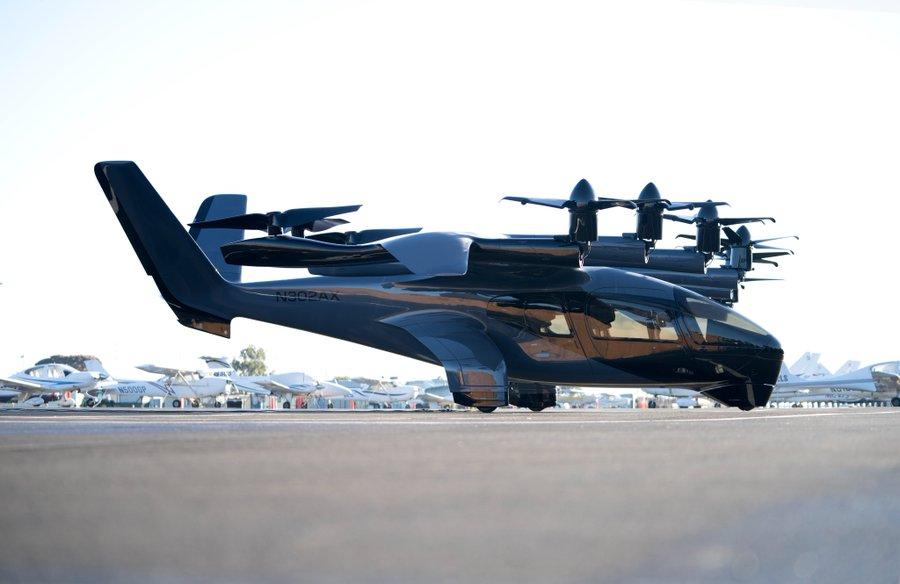
Midnight eVTOL.
Automobile manufacturer Stellantis has deepened its partnership with electric vertical takeoff and landing aircraft (eVTOL) manufacturer Archer Aviation, with a deal to invest up to $150 million in the company.
The Amsterdam-based company, parent to the Fiat, Chrysler and Peugeot car brands, will also help Archer manufacture its Midnight four-passenger air taxi at the startup’s forthcoming factory in Covington, Georgia, starting in 2024 by loaning personnel and expertise.
As part of the deal, Stellantis will provide up to $150 million in equity capital to be potentially drawn by Archer at its discretion in 2023 and 2024, based on the achievement of undisclosed business milestones anticipated this year, San Jose, California-based Archer said Jan. 4. It also intends to increase its stake in Archer through future purchases of Archer stock on the open market.
The automaker says it aims to be a “long-term, cornerstone investor in Archer” and “to mass produce Archer’s eVTOL aircraft as its exclusive contract manufacturer.”
Stellantis has been partnered with Archer since 2020 and invested in the company in 2021. The eVTOL upstart has leaned on Stellantis’ manufacturing expertise.
Archer plans to build a 350,000-ft.2 factory at a site adjacent to Covington Municipal Airport that would be capable of producing up to 650 aircraft per year, it said in November. The company has ambitious plans to rapidly increase production, with a goal of 250 units in 2025, 500 in 2026 and 650 in 2027. By the end of 2030, it expects to have made nearly 6,000 aircraft.
Archer plans to invest $118 million of its own capital over the next 10 years in its Covington facility. It will also receive an incentive package from the state of Georgia.
The eVTOL company plans to build at least eight production-representative prototypes of its Midnight in 2023 and 2024. Moving from producing fewer than a dozen aircraft to 250 aircraft per year is unheard of in the commercial aerospace industry. Archer has said it will rely on Stellantis’ automotive manufacturing expertise to meet its goals.
Carlos Tavares, Stellantis CEO, notes that his company manufactures about 550,000 cars per month and each has about 4,000 parts.
“We know how to make high-volume manufactured goods,” he says. “We know how to make manufactured goods with precision, a lot of rigor, a lot of quality. This is exactly where we can help this company.”
Archer plans to offer air taxi services for $3 to $4 per mile—similar to the cost of a ground-based ride-sharing service. The company is confident it can offer those prices when it goes to market in 2025 and believes it can push prices down even further as it gains economy of scale savings from ramping up production, says Adam Goldstein, CEO and co-founder of Archer.
“The bill of materials is largely understood; the majority of it is under contract and signed up,” he says. “We actually have a very good understanding of what these vehicles will cost to build.”
The biggest unknown cost is landing fees, as vertiports have yet to be built, Goldstein says. Accordingly, Archer will initially focus on serving as a shuttle service between large airports and dense urban areas, where existing helipads are available and demand is predictable.
In November, Archer and United Airlines announced an air taxi route from the Downtown Manhattan Heliport to Newark Liberty International Airport in New Jersey. The approximately 14-mi. journey along surface streets can take a taxi nearly an hour during evening rush hour, but Archer expects its Midnight aircraft to fly the route in less than 10 min.
Archer sees establishing “trunk routes” to and from large airports as a good starting point to expand air taxi services.
“From there, we would launch branch routes off the trunk routes, and start connecting them all together into a network,” Goldstein says.

Comments
But the biggest problem is that the laws of physics do not allow a flying machine to provide costs which are similar to "a ground-based ride-sharing service." Sorry, this can not be done. In terms of energy required, it will take more to keep four people in the air than in a vehicle moving on the ground. And the regulatory requirements for flying machines will always be more expensive than for cars. Advanced Urban Air Mobility is not going to be as cheap as its developers contend.